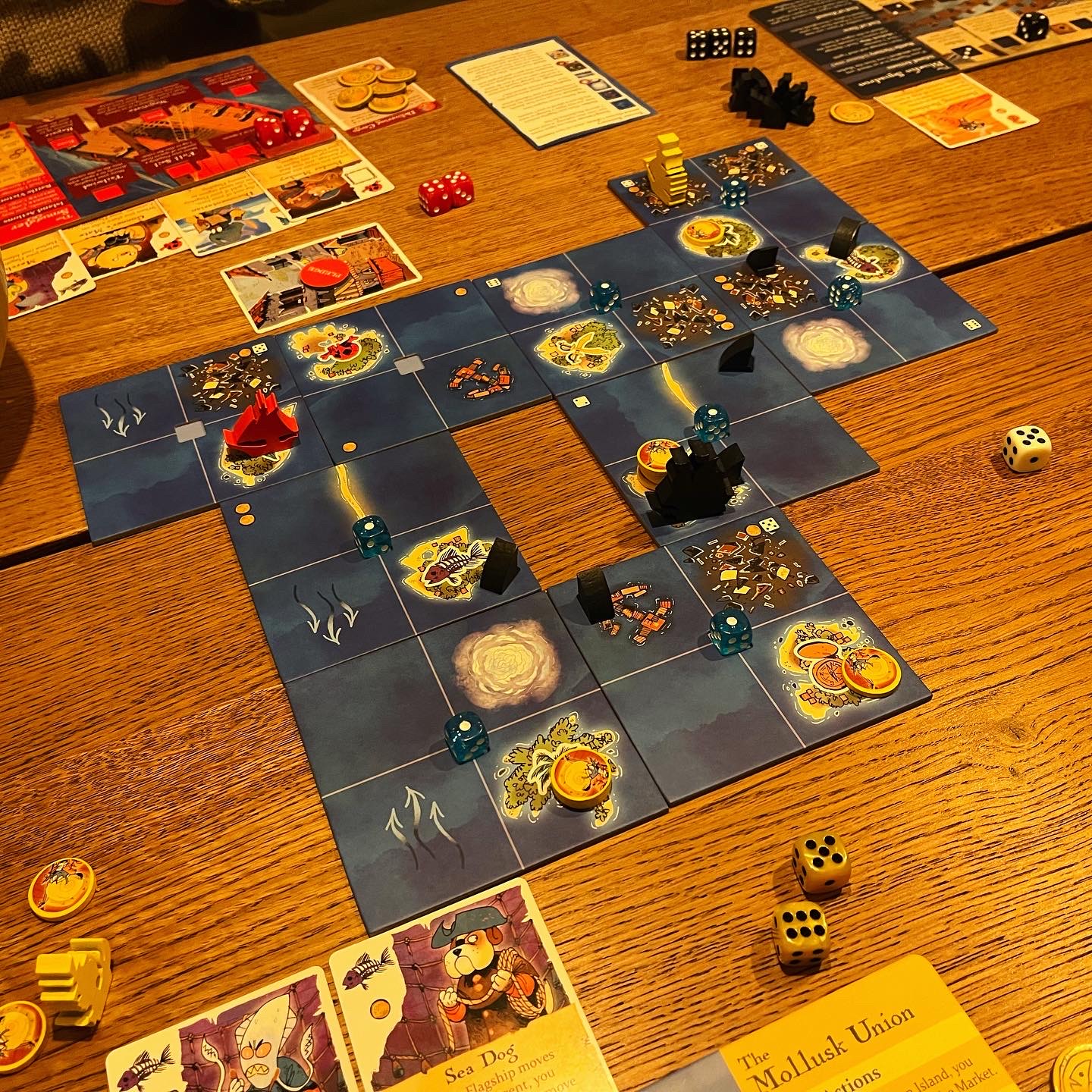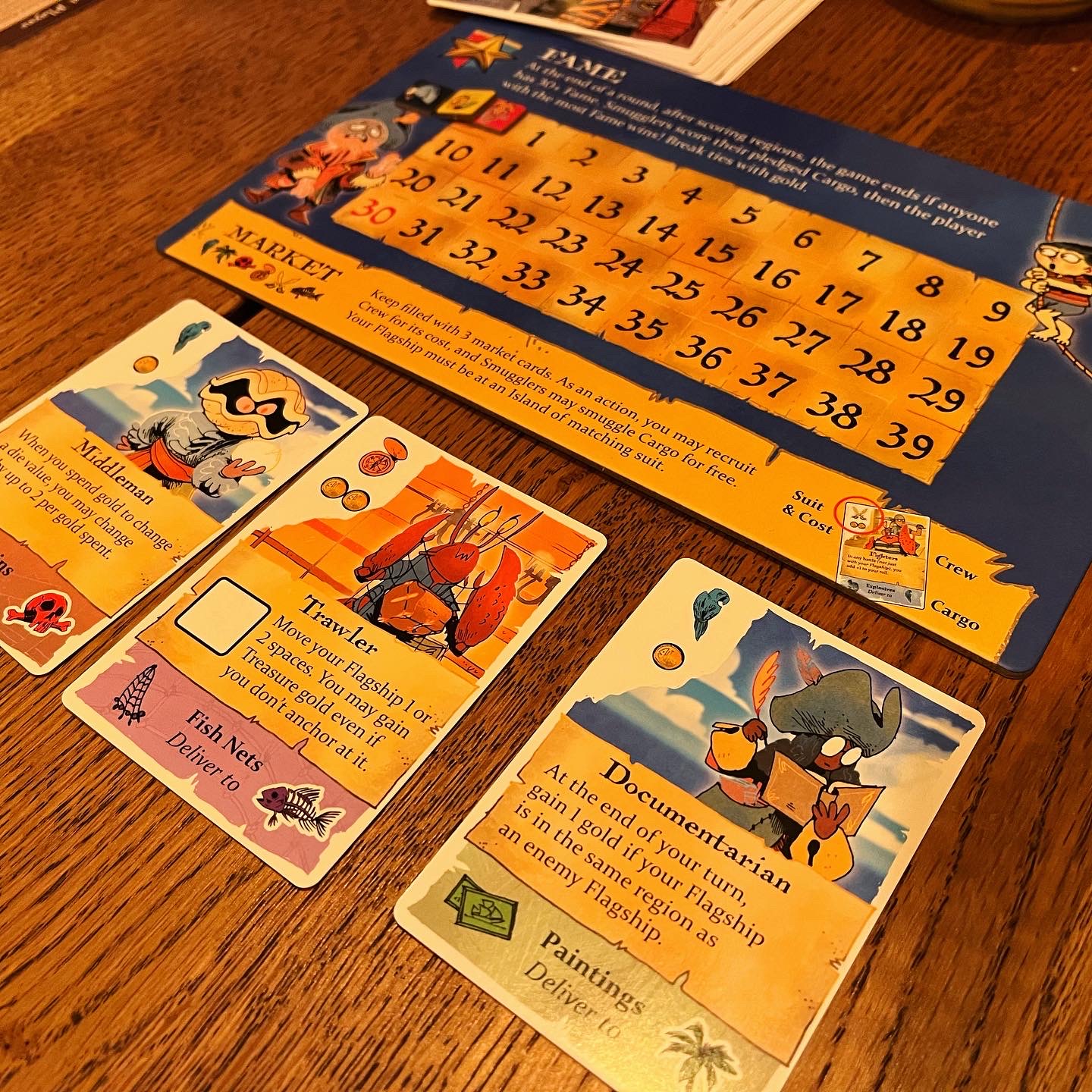Ahoy mates, hoist the sails: we’re off hijacking, keelhauling, colonising, kidnapping and carrying out all the other nasty things that pirates and seafarers have on their conscience. Piracy is a crime but the line between piracy and privateering is very thin. In the game Ahoy, players try to become famous (or infamous) seafarers. Depending on your actions, fame or fear will fluctuate like ebb and flow. Are you heading for victory or a proverbial burial at sea?

In this new game by Leder Games, very appropriately named Ahoy, players are smuggling and seafaring as the game’s subtitle also rightly suggests. Like the other games by Leder games, this game has been brilliantly illustrated by Kyle Ferrin which makes the game look colourful and characterful just like Root of Oath. Based on the graphic design alone, players should have a Leder Games game in a collection. What about Ahoy?
Goal and different factions
Like Leder Games’ other games, this game is again largely asymmetrical. Players should be aware of this, as (almost) each player has a set of different actions, tactics and strategies at his or her disposal. In the game, each player assumes the role of a seaworthy selection of rascals. More on that below. Due to the asymmetrical nature of the game, it feels like players with different factions are playing a completely different game. Two of the factions vie for control over different regions of the seven seas while a pair of smugglers try to collect and deliver goods purely for fame.
In Ahoy, there are four playable factions. Depending on the number of players (2 – 4), certain factions may or may not be available. Like a ship’s sail in harsh winds, the atmosphere between the different factions (and also the players) is tense, and as soon as the tide turns, tempers become grimm. What factions are there?
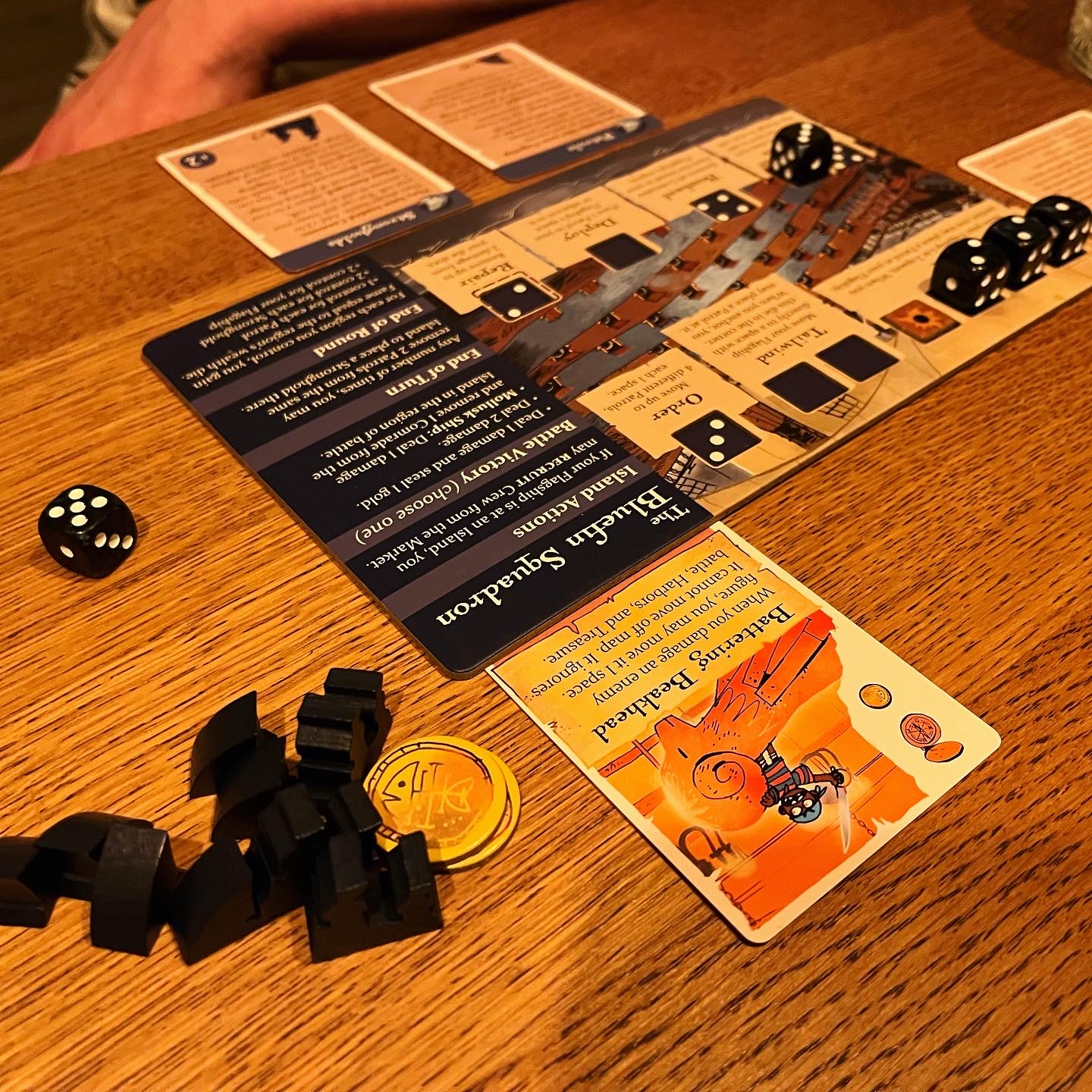


- One player takes on the role of the Bluefin Squadron. These hawkish sharks and their finned friends (who, incidentally, are also not afraid to bare their teeth) are seen patrolling the waters as if they are in charge. With a rich naval fleet of sharks, forts and a powerful flagship, they try to keep the waters weak with a strong arm. These blue biters can easily build up an army, make their cannons strong and ready, and have an extra action every round easily turning the other players into involuntary cannon fodder;
- The Mollusk Union has been living underwater and underground for ages, literally and figuratively. This conglomeration of shellfish is trying to reclaim their original home and a (hopefully) large company of comrades. This alliance is trying to win support on the various islands. They also have some tricks up their sleeves. Literally: the Mollusk Union gets a deck of cards, which they can use to influence outcomes of battles, among other things. Don’t put all the cards on the table right away, though…
- The last two players both take on the role of Smugglers. These smugglers try to collect goods on different islands and smuggle them like mad back to other islands. While both the Bluefin Squadron and the Mollusk Union collect points through control of the various regions, the Smugglers have a stake in the outcome of this battle in their own way. They can pledge to the other two factions hoping to rack up some extra points at the end of the game. Therefore, it can also be interesting for the Smugglers to attack the other factions to possibly settle the outcome of the battle.
Setup and gameplay
At the beginning of the game, each player is given a faction and its components, including a player board, a ship or ships and some dice. Two tiles (regions) are placed on the table. A die with the value of one is placed on each tile. There should be enough space on the table so that several tiles can be placed. Next to the open tiles is the draw pile. Players also place the central game board with the scoring area and, below it, three crew cards are placed face-up to form the ‘market’.
The game proceeds in rounds and at the beginning of each turn, all players (re)roll all of their dice. Each turn, a player must use two dice. Except for the Bluefin Squadron, each faction has four dice and therefore two turns per round. The Bluefin Squadron has five dice and may play an extra turn at the end of the round.
Dice and actions
With the available dice, players can trigger actions. Some actions require a specific value of dice, but players can use coins to increase or decrease the value of a dice. Each turn, players deploy two dice. No more, no less. After all, the sea is unrelenting.
A number of actions are available to each player such as moving or loading cannons. Players can also recruit crew members on islands. These crew earn bonuses. Sometimes buying crew costs a die. Besides the ‘basic actions’, players also have unique actions and traits. Bluefin Squadron can place patrols and strongholds. The Mollusk Union has different actions to gather and place comrades. Incidentally, comrades and patrols can just as easily be removed again by actions of the different factions. The smugglers can more easily recruit crew and also smuggle goods. Smuggling they can even do without deploying dice.
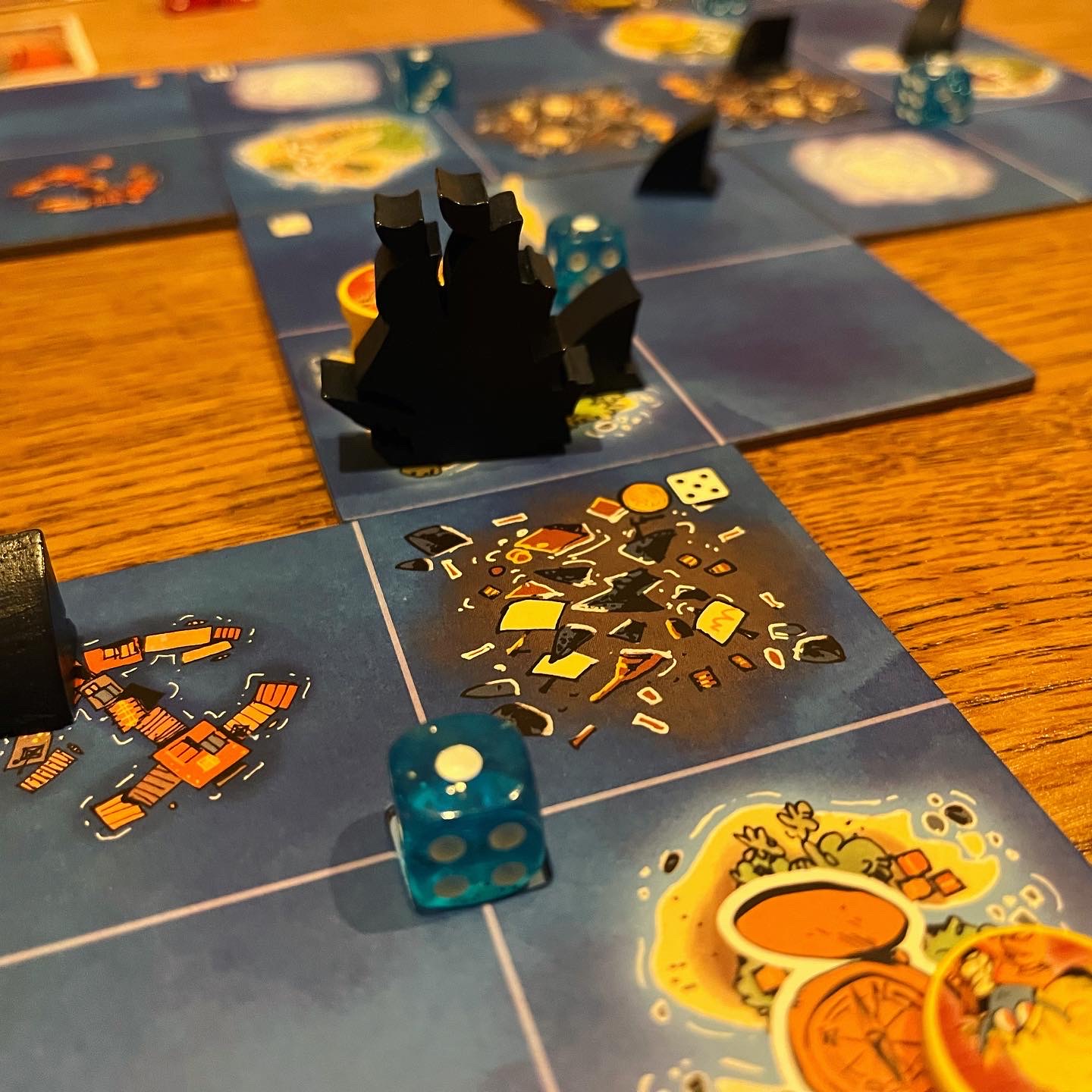
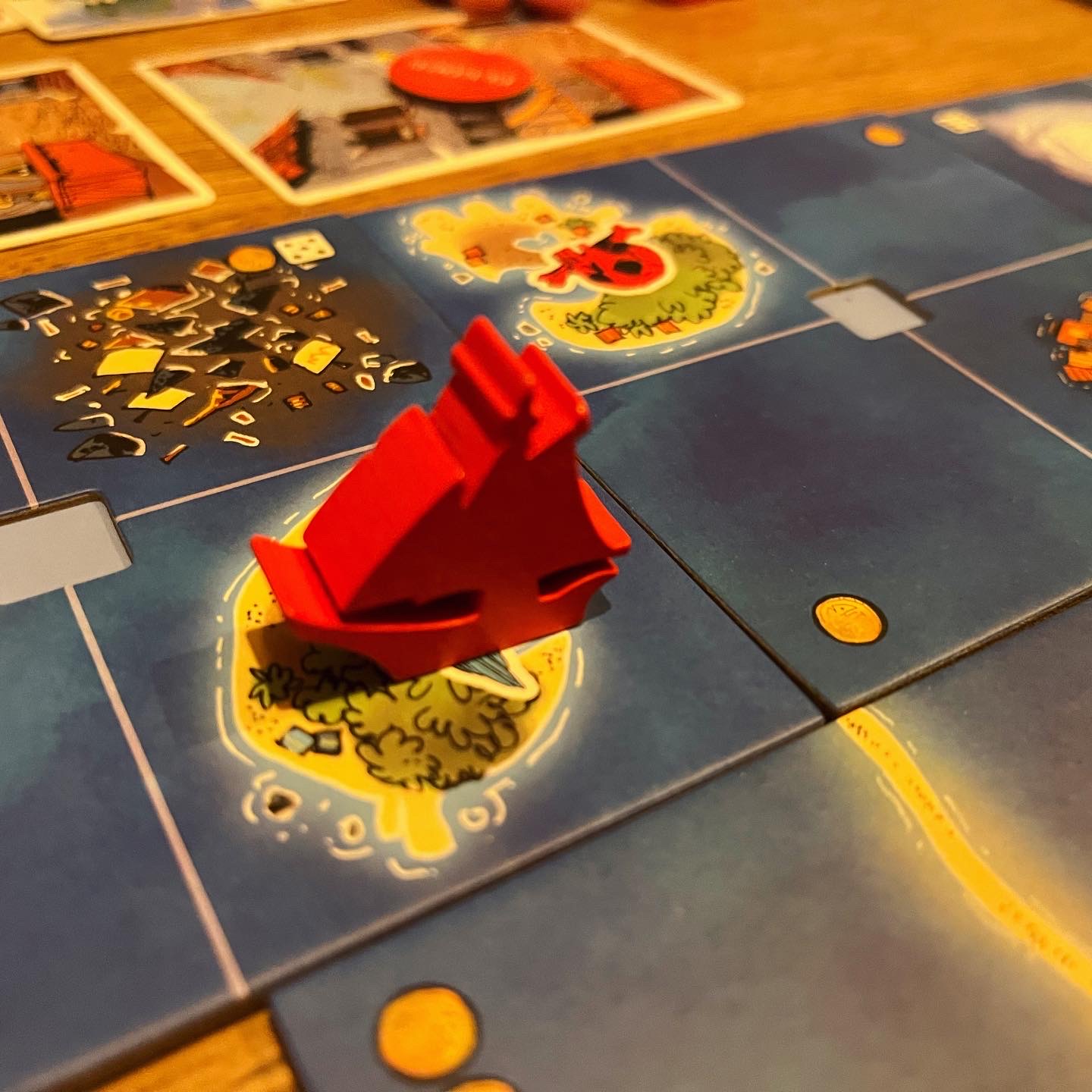
Moving, exploring and fighting
There are different types of options for movement. For example, players can use a die to move (for example) their flagship 1 or 2 squares (each tile has four squares). In addition, they can use a specific dice roll to move to a specific corresponding square. Tail the winds and sail the high seas! Smugglers, of course, have some kind of speedboat and have another specific action where they can move as many squares as the die they roll.
As players move, they can potentially discover new tiles. If they sail off a tile, they may, if possible, place a new tile that players can subsequently sail on. The tiles possible include new islands, shipwrecks, ports and or treasures that players can visit. If they lower their anchors (end movement), special tiles may deliver effects. In some cases, players must end their movement. This is the case, for example, if they discover tiles or if they have to fight a battle.
Another action players have is loading cannons. If players land on a field with an enemy piece and if she or that enemy piece has loaded cannons, then a battle takes place. Players can lower the die they have loaded in their cannon to increase combat value. Players roll a die and the player with the highest combat value (use of loaded cannon plus the rolled value) wins. This player gets a bonus and may deal damage as a result. Damage means a player has fewer actions available.
Earning fame
Smugglers earn fame (victory points) by smuggling goods to islands. They also have a reward track through which they can earn extra bonuses and also fame. Each time they deliver goods to a region, the value of the region goes up (indicated by the die placed on the region tile). At the end of each round (when all action dice have been used), it is calculated whether the Mollusk Union or the Bluefin Squadron has control over certain regions. These factions earn points depending on the value of a region.
Verdict
I have a huge soft spot for Leder games. Kyle Ferrin is one of my favourite illustrators and Leder games gives me exactly what I often look for in board games: a varied and asymmetrical challenge with gameplay infused with theme. The asymmetrical nature means players have to re-approach their strategy time and again. As a result, Ahoy also offers exactly what I am looking for.
What I think of Ahoy is that despite its asymmetric nature, the game is not overwhelmingly complex. Root and Oath are harder to explain to novice players because of the many different little rules and details, but with Ahoy, the basics in essence the same for every player. Roll the die and deploy it efficiently to link different actions together. The game may be easy to explain, but difficult to master precisely because of the different factions and strategic approaches. This makes you want to explore the game, like the waters, in order to become a famous seafarer.
The game is, like a keeled pirate drenched in salty water, soaking with theme. Players can choose, after doing damage, for example, to do extra damage to board and plunder anyway. The different factions also represent all the stereotypes sailing the seven seas. So put on a nice matching soundtrack (by Hans Zimmer, for instance) on the background and go sailing together. Loosen up, cast off and ship Ahoy!
